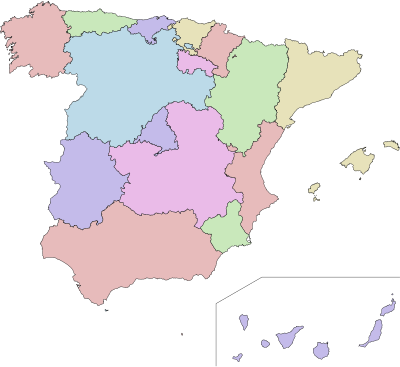Autonomous communities of Spain
| Autonomous communities | |
|---|---|
| Category | Autonomous administrative division |
| Location | Spain |
| Created by | Spanish Constitution of 1978 |
| Created | 1979–1983 |
| Number | 17 (+2 autonomous cities) |
| Populations | Autonomous communities: 321,171 (LO) – 8,415,490 (AN) Autonomous cities: 81,323 (ML), 83,517 (CE) |
| Areas | Autonomous communities: 94,223 km2 (36,380 sq mi) (CL) – 1,927 km2 (744 sq mi) (IB) Autonomous cities: 4.7 km2 (1.8 sq mi) (ML), 7.1 km2 (2.7 sq mi) (CE) |
| Government | Autonomous government |
| Subdivisions |
Province Comarca Municipality |
In Spain, an autonomous community (Spanish: comunidad autónoma, Basque: autonomia erkidegoa, Catalan: comunitat autònoma, Galician: comunidade autónoma) is a first-level political and administrative division, created in accordance with the Spanish constitution of 1978, with the aim of guaranteeing limited autonomy of the nationalities and regions that comprise Spain.
Spain is not a federation, but a highly decentralizedunitary state. While sovereignty is vested in the nation as a whole, represented in the central institutions of government, the nation has asymmetrically devolved power to the communities, which, in turn, exercise their right to self-government within the limits set forth in the constitution and their autonomous statutes. Some scholars have referred to the resulting system as a federal system in all but name or a "federation without federalism". There are 17 autonomous communities and two autonomous cities that are collectively known as "autonomies". The two autonomous cities have the right to become autonomous communities, but neither has yet used this right. This unique framework of territorial administration is known as the "State of Autonomies".
The autonomous communities are governed according to the constitution and their own organic laws known as Statutes of Autonomy, which contain all the competences that they assume. Since devolution was intended to be asymmetrical in nature, the scope of competences vary for each community, but all have the same parliamentary structure.
(Only seat of the institutions, but not officially capital)
Spain is a diverse country made up of different regions with varying economic and social structures, as well as different languages and historical, political and cultural traditions. While the entire Spanish territory was united under one crown by the 16th century, this was not a process of national homogenization or amalgamation. The constituent territories—be it crowns, kingdoms, principalities or dominions—retained much of their former institutional existence, including limited legislative, judicial or fiscal autonomy. These territories also exhibited a variety of local customs, laws, languages and currencies until the mid nineteenth century.
...
Wikipedia

